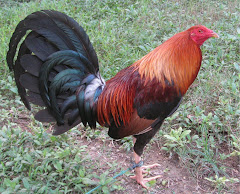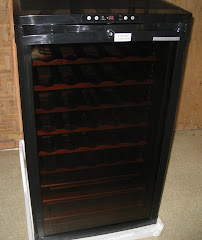
Nutrition, Stress, and The Gamecock
By John W. Purdy
copyright©2000
The most important nutrient in life is water. Water composes, on average, 55% of the adult chicken's body weight - over 2.5 pounds of water in a 5 pound rooster! Obviously, the quality of water we give our fowl has a huge impact on the quality of their performance in the pit, in the broodpen, and on their overall health. Access to fresh and clean water gives fowl the opportunity to digest food properly, regulate body temperature, and carry out the thousands of biochemical process that keep them kicking.
A chicken has the unique ability to tolerate poor quality water and survive. We have all seen water containers that were less than clean, yard fowl drinking from stagnant puddles, and yet the chickens seemed fine. What is not apparent is that the chicken's immune system is constantly battling the germs found in the water, as well as all the other germs in the air and soil, from wild bird droppings, etc. Obviously, in response to this "stressor" the natural resistance of the bird can be overcome and disease may develop. To help prevent this from happening, and to eliminate one "route of exposure", simply change the water frequently, and make sure it's clean. This will allow the chicken to use its energy to fight off other potentially harmful bacteria and viruses, develop strong and flexible feathers, muscle, bone, and body systems that will be vitally important in the pit and in the broodpen.
Although chlorinated water is sanitary, chlorine is a strong chemical that I feel should be avoided when conditioning roosters. In fact, there are a variety of chemicals used to treat drinking water that are not beneficial to a gamecock in a conditioning program. If your source of water is treated with chemicals, there are a couple of possible solutions you should know about. First, since chlorine rapidly changes into a gas, leaving your buckets or jugs uncovered overnight will allow most of the chlorine to evaporate. Another solution is to use an activated carbon water filter. These filters are widely available, inexpensive, and very effective in removing a variety of chemicals. Bring a jug of de-chlorinated water with you to the pit. Changing the source of drinking water with sharp cocks the day of, or before the fight, can be a mistake.
If drinking contaminated water can be a source of stress for gamefowl, then what are examples of other stressors? And what is a stressor, anyway? A stressor is any factor in a chicken's environment that challenges the "normal" condition and forces the bird to make an adjustment as a response. For example, the heat from the sun (the environmental factor) causes the body temperature of your favorite rooster to increase (the change from normal), and he begins to pant (the response). The response to a stressor is usually negative, because the bird will often have to reallocate energy and nutrients. In this example, your favorite rooster is expending extra energy to get rid of the excessive body heat. Energy production is dependent upon the breakdown of carbohydrate and fats, requiring many vitamins and minerals including thiamin, niacin, and riboflavin, in addition to magnesium, as "co-enzymes". He will also have to move large amounts of extra carbon dioxide, which increases the blood pH, requires electrolytes, changes critical water balance and so on. As the air temperature increases, the difference in temperature between the rooster's body and the air decreases, and the rate of heat loss is reduced. Since chickens don't have sweat glands, they have to use a variety of other ways to remove heat from their bodies. They'll seek shade, pant rapidly, and spread their wings so that air currents will remove the layer of hot air next to their feathers. They'll often lie on the ground, with legs and wings spread, so that heat will travel from their body to the cooler ground. The combs and wattles provide surface area for the blood to transfer heat to the air, but we take that option away when we trim our stags.
To reduce the effects of heat stress, feed early in the morning and late in the evening in hot weather, so that the heat of metabolism (digestion) does not occur in the hottest part of the day when the fowl are trying to cool off. Provide shade for your fowl, and place their water containers in this location. Provide additional water containers for young fowl running loose. Provide electrolytes in the drinking water 3 times per week. If the birds eat less (as they will in hot weather), increase the concentration of nutrients in their diet, so they are getting the same amount of protein, energy, vitamins and minerals. Supplement their diet with fruit containing high moisture content such as apples, peaches, bananas, pears, mangos, etc. If you discover a bird who is under severe heat stress and he appears to be on the verge of collapse, dunk him into cool water (not cold) and keep him in the shade. I once had a box full of black day-old chicks that I placed in the sun while I was preparing the brooder pen. It didn't seem that hot, but in 20 minutes, most had passed out and several died. Boy, did I feel stupid! I moved them in the pen, flicked droplets of water on them, while praying to the Big Rooster in the sky (these chicks belonged to my employer!). In a few minutes they started peeping and soon were running around, seemingly fresh and ready for their next experience!
Heat stress is an example of a physiological stressor. Other types of physiological stressors are rapid growth, high egg production, intensive conditioning, sparring, poor water and/or feed quality, disease challenge, parasites, and vaccinations. In general, stress increases the destruction, utilization and synthesis of glucose and fats, increases the degradation of muscle protein, increases hormone production such as corticosteroids (e.g., adrenaline), insulin, and glucagon, and has a negative impact on electrolyte balance.
Psychological stressors are also important to consider. Hawks flying overhead are an example of psychological stress. Gamefowl are remarkably adaptive to this type of stress, once they become accustomed to it. In preparing fowl for battle, many people play loud music in the cockhouse 24 hours a day to accustom the birds to the loud noises they will experience at the pit. This is a good idea. Frequent and gentle handling of cocks and stags prior to the Keep is also beneficial. Get your birds used to all the strange experiences they may experience at the pit. Remember - you want a sharp, focused rooster when you set him down on the score line. A good friend of mine puts his birds in carrying cases during the Keep, carries them around the cockhouse, and takes them for a ride in the truck. You might think this is extreme, but it's little details that often make the difference. Use 2' x 2' stalls when you feed your evening feed. This is the type of holding stall you'll use at the pit. Rub their legs frequently so they get accustomed to pressure on their legs and around their spurs - they're less likely to kick and struggle when you're heeling for battle. When you spar your roosters, have a couple of friends come over and yell at each other and wave their arms around to simulate the crowd your rooster will surely be surrounded by at the pit. Changing the person with whom the birds are comfortable with (the feeder) when you get to the pit can also make them nervous. Try to insure that the feeder/conditioner is also the handler, or have the handler help spar the fowl during the Keep. Always use a few experienced cocks when you spar fresh, unfought roosters. This will increase their "awareness" in a hurry! Nutritional supplementation also gives birds under psychological stress the "tools" to respond and recover more rapidly.
Some breeds of fowl tend to handle stress better than others. Oriental fowl are famous for their calm disposition, disease resistance and tolerance to close confinement. Highly inbred fowl are often nervous and are more difficult to condition because of their inability to handle stress. Nervous or "high-strung" fowl are quite a challenge to bring to "point" on fight-day, but when they're "right" look out! If you have high-strung fowl, it is VERY important to spend a lot of time in the conditioning process to accustom them to handling, hauling, confinement in the cockhouse stalls, sparring, loud noises, etc.
As experienced cockers know, it's not easy to get that extra 10% performance, the last shuffle, the last peck, and that elusive money-fight. How you handle the interaction between stress, nutrition and performance has a major part in accomplishing your goals in this sport.








